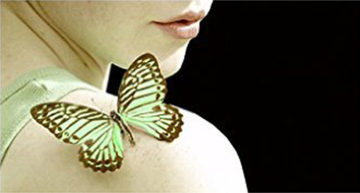 Lelo’s Etherea Silk Cuffs (a black version is part of their Dare Me Pleasure Set)
Lelo’s Etherea Silk Cuffs (a black version is part of their Dare Me Pleasure Set)
The following is from our very own naughty, award-winning dictionary, 150 SHADES OF PLAY: A Beginner’s Guide to Kink. Bolded words signify individual entries that appear elsewhere in the A-to-Z section of the book. Anything with a tie icon ![]() indicates an activity or prop mentioned in the Fifty Shades series (symbolic of the famous woven tie Christian Grey uses to restrain Anastasia Steele). The idea being: look up something you’re interested in and, from there, make it a choose-your-own-adventure book by following any bolded words that pique your interest to their own dedicated entry. Or just start at A and don’t stop ‘til you get to Z—or ‘til you’re compelled to try something out with your partner, whichever comes first!:
indicates an activity or prop mentioned in the Fifty Shades series (symbolic of the famous woven tie Christian Grey uses to restrain Anastasia Steele). The idea being: look up something you’re interested in and, from there, make it a choose-your-own-adventure book by following any bolded words that pique your interest to their own dedicated entry. Or just start at A and don’t stop ‘til you get to Z—or ‘til you’re compelled to try something out with your partner, whichever comes first!:
C
cuffs, ankle and wrist 
If restraining someone by their wrists and ankles is the meat-and-potatoes of bondage, then made-for-play cuffs (sold at any sex toy store) are bondage’s Hungry-Man frozen dinners: quick, easy, and surprisingly satisfying. Bondage cuffs are way safer than handcuffs and provide instant gratification—unlike rope, with its pain-in-the-ass learning curve. Most cuffs are made of either leather or nylon (for kinky vegans, e.g. Super Cuffs) and are often
lined with faux fur, etc. (for comfort even during marathon seshes). And before you complain that faux fur is “not me” or “so last season,” just try writhing around in a pair of police-issue handcuffs first. For real-world restraints that aren’t a pain in the wrist, check out the surprisingly attractive institutional cuffs at MedicalToys.com. And for something a little more in line with the high-end Fifty Shades aesthetic, check out LELO’s Etherea Silk Cuffs and Sutra Chainlink Cuffs.
Bondage cuffs feature either buckles or Velcro (the former gives a stronger hold, the latter a quicker release and a sexy sound) and are fairly wide (at least two to three inches) to ward off the nerve damage that is a risk of traditional handcuffs. Speaking of risks: As with any form of bondage, the bottom should speak up as soon as he or she notices any numbness or tingling, and the top should allow for at least one finger’s width between cuff and skin. And regular bondage cuffs should never be used for any kind of suspension — you need special equipment for that sort of advanced play (although you should never suspend someone from the wrists, no matter the gear). Bondage cuffs typically feature D-rings so that they can be tethered to each other, to bed posts, to chair legs, etc. And if you’re still sleeping on your college futon? Most sex toy shops sell “Under the Bed” tethers that serve as makeshift bedposts. Another option is to attach the ankle or wrist cuffs to a spreader bar. For more self-contained bondage, just attach wrist to wrist and ankle to ankle. You can even attach bound wrists to bound ankles (either in front or back) for an instant hogtie! See also bondage safety, collars, cuffs (grip), cuffs (rope), door jamb cuffs, and handcuffs.
For more on restraints and other kinky endeavors, pick up a copy 150 SHADES OF PLAY, on sale now at Amazon!





















